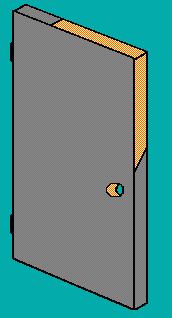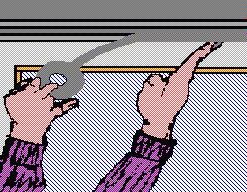DOORS - KINDS, TYPES, & HOW TO MAKE ENERGY EFFICIENT

- GOAL:
- To make students aware of the kinds of doors available, their efficiency, and how to make existing doors more energy efficient.
- OBJECTIVES:
- The student will be able to identify the types of doors and kinds of weatherstripping available for doors.
- LESSON/INFORMATION:
- Doors are subject to wear and tear by people and by weather. The four primary types of doors are:
- 1. Panel Door - cosists of wood panels held in place by wood stiles and rails; panels can be made from solid wood,
plywood, metal or glass.
- 2. Solid Core Door - consists of a solid lumber core, compressed wood fiber core, or rigid foam board laminated to plywood or metal facing. Example shown below.

- 3. Hollow Metal Insulated Door - consists of shop fabricated and welded sheet metal. Mineral or cement board (fire resistant or rigid foam board/insulation) is usually added as a core.
- 4. Hollow Core Wood Door - consists of a plywood or press board face and a honeycomb wood or paper interior core; hollow core wood doors are usually for interior use only.
- Since homes have several doors to enter or exit, it is important to look at the efficiency of these doors. This can be done by selecting an efficient door or by making an existing door more efficient with weatherstripping.
- The Hollow Metal Insulated Door is the best choice for use in new construction or in remodeling. With an R-value of 3-6, it is the wisest choice for the home owner. Another choice is the installation of a storm door. Storm doors should have tempered glass and a kickplate at the bottom to prevent damage. Remember, look for "tightness" in the unit to prevent the entrance of water, air, dust and insects.
- Weatherstripping A Door
- Weatherstrips must be made of flexible material in order to seal securely. Most weatherstripping is designed for "do it yourself" installation.

- Some types available are:
- 1. Spring Metal Strips - made of bronze, brass or aluminum sold as flat tension strips in rolls to be used between jambs and door surfaces.
- 2. Tube Weatherstripping - made of plastic, rubber, PVC or silicone; usually applied on the outside.
- 3. Felts Strips - attached to metal or wood reinforcing or plain felt with adhesive backing; should be used where little weathering is expected, as it is not very durable. It is available in various widths and thicknesses.
- 4. Foam Strips - made of vinyl, sponge rubber, neoprene or polyurethane, comes with adhesive backing or attached to wood or metal flange; should be used on interior.
- 5. Plastic Strips - comes with adhesive backing, which can be used between sliding or closing surfaces that press against each other.
- 6. Specialized Weatherstrips - these are special shapes of PVC, EPDM Rubber or silicone that fit into grooves cut into the door jambs.
- INFORMATION CHECK:
- Matching (Doors)
- ____ 1. Storm
- ____ 2. Hollow Core Wood
- ____ 3. Hollow Metal
- ____ 4. Metal Insulated
- ____ 5. Solid Core
- ____ 6. Panel
- a. Door created from panels, stiles and rails.
- b. Constructed of compressed wood
- c. Fabricated door
- d. Door used to provide ventilation and light
- e. Interior use only
- f. Wisest choice for exterior doors
- Matching (Weatherstripping)
- ____ 1. Spring Metal Clip
- ____ 2. Tube Weatherstrip
- ____ 3. Felt Strips
- ____ 4. Foam Strips
- ____ 5. Plastic Strips
- ____ 6. Specialized
- a. Specific shapes for specific grooves
- b. Usually applied on outside
- c. Flat tension strips
- d. Basically used on interior doors
- e. Used on B/W sliding surfaces
- f. Used on interior doors; nailed
- ACTIVITY 1:
- Compare the costs of various kinds of doors. Contact your local lumber or building supply company to obtain prices.
- Survey your own home and list the types of weatherstripping used or needed. If your home needs weatherstripping, compare the cost of using various kinds of weatherstripping.
- TEACHER'S NOTES:
- ACTIVITY 1:
- Matching (Doors)
- 1. Storm = D
- 2. Hollow Core Wood = E
- 3. Hollow Metal = C
- 4. Metal Insulated = F
- 5. Solid Core = B
- 6. Panel = A
- Matching (Weatherstripping)
- 1. Spring Metal Clip = C
- 2. Tube Weatherstrip = B
- 3. Felt Strips = D
- 4. Foam Strips = F
- 5. Plastic Strips = E
- 6. Specialized = A
Comments or questions to: TechAsmt@LA.GOV
Return to Carpentry Menu



